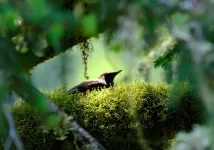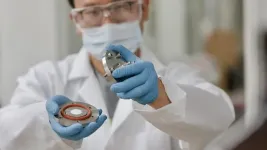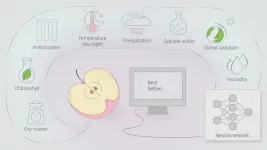Architecture of Eolian successions under icehouse and greenhouse conditions
New study published in Geological Society of America Bulletin
2021-03-30
(Press-News.org) Boulder, Colo., USA: Anthropogenic climate change is one of the foremost scientific and societal challenges. In part, our response to this global challenge requires an enhanced understanding of how the Earth's surface responds to episodes of climatic heating and cooling. As historical records extend back only a few hundred years, we must look back into the ancient rock record to see how the surface of the Earth has responded to shifts between icehouse (presence of ice at the Earth's poles) and greenhouse (no substantial ice at Earth's poles) climates in the past.
In their study published last week in GSA Bulletin, Grace Cosgrove, Luca Colombera, and Nigel Mountney use a novel relational database (the Database of Aeolian Sedimentary Architecture) to quantify the response of ancient eolian systems (i.e., wind-dominated environments, such as sand dune fields) to global climatic shifts between icehouse and greenhouse climates, as registered in the rock record. They analyzed data on thousands of geological features that preserved a record of eolian processes and landforms, from 34 different eolian systems spanning over two billion years of Earth's history.
Their results demonstrate statistically that preserved sedimentary architectures developed under icehouse and greenhouse conditions are fundamentally different. These differences can be tied to contrasting environmental conditions existing on Earth's surface. During icehouse climates, alternations between glacial and interglacial episodes (caused by changes in the Earth's orbit--the so-called Milankovitch cyclicity) resulted in cycles of glacial-episode accumulation and interglacial deflation.
Greenhouse conditions instead promoted the preservation of eolian elements in the geological record due to elevated water tables and the widespread action of biogenic and chemical stabilizing agents, which protected deposits from wind-driven deflation.
In the context of a rapidly changing climate, the results presented in this work can help predict the potential long-term impact of climate change on Earth surface processes.
INFORMATION:
FEATURED ARTICLE
Quantitative analysis of the sedimentary architecture of eolian successions developed under icehouse and greenhouse climatic conditions
Grace I.E. Cosgrove; Luca Colombera; Nigel P. Mountney
Contact: Grace Cosgrove, g.i.e.cosgrove@leeds.ac.uk, University of Leeds, IAG, Leeds, UK
View article: https://pubs.geoscienceworld.org/gsa/gsabulletin/article-abstract/doi/10.1130/B35918.1/595649/Quantitative-analysis-of-the-sedimentary
GSA BULLETIN articles published ahead of print are online at https://bulletin.geoscienceworld.org/content/early/recent. Representatives of the media may obtain complimentary copies of articles by contacting Kea Giles. Please discuss articles of interest with the authors before publishing stories on their work, and please make reference to The Geological Society of America Bulletin in articles published. Non-media requests for articles may be directed to GSA Sales and Service, gsaservice@geosociety.org.
https://www.geosociety.org
ELSE PRESS RELEASES FROM THIS DATE:
2021-03-30
NEW YORK, NY (March 30, 2021)--Early in the pandemic, neurologists expressed concern that COVID-19 patients with dementia may be at higher risk for complications and mortality.
But those fears have not been realized, according to a new study of patients who were hospitalized with COVID-19 during the first wave of the pandemic in New York City. The study, led by James Noble, MD, MS, associate professor of neurology at Columbia University Vagelos College of Physicians and Surgeons and the Taub Institute for Research on Alzheimer's Disease and the Aging Brain, and Amro Harb, a Vagelos medical student, was published this month in ...
2021-03-30
A year ago scientists everywhere were scrambling to get their minds around the SARS-CoV-2, a novel coronavirus that caused the pandemic from which we are only now beginning to emerge. The world clung to every new development, every bit of science that could provide clues to managing life in the presence of this mysterious killer.
Many science-backed COVID-19 management concepts remain unchanged to this day: handwashing with soap and warm water disrupts the virus' lipid membrane. Social distancing can attenuate the virus's spread, ideally keeping it out of a host until it degrades. Other notions, such as droplet contact being the primary mode of transmission, were modified when emerging evidence showed that under ...
2021-03-30
Not all species may travel the same path to existence, at least according to new findings from the University of Colorado Boulder and collaborators.
This new research, out now in Science, looked at a newly discovered, endangered songbird located only in South America--the Iberá Seedeater--and found that this bird followed a very rare evolutionary path to come into existence at a much faster pace than the grand majority of species.
By comparing this bird to a closely related neighbor (the Tawny-Bellied Seedeater) in the same group (the southern capuchino seedeaters), the researchers determined that genetic shuffling of existing variations, rather than new random mutations, brought this species into existence--and their ...
2021-03-30
CORVALLIS, Ore. - Oregon State University researchers broadcast marbled murrelet calls in mature forests and found that the threatened seabirds' choice of breeding locations is strongly influenced by whether they hear other murrelets in the area.
The research by scientists in the OSU College of Forestry and College of Agricultural Sciences is important because the elusive seabird's populations are in decline and recovery may be hindered by there being too few birds around to provide information to each other about where to nest.
Findings were published in Ornithology, the the flagship journal of the American Ornithologists Union.
"The odds that marbled murrelets would ...
2021-03-30
On sultry summer afternoons, heating, ventilation and air conditioning (HVAC) systems provide much-needed relief from the harsh heat and humidity. These systems, which often come with dehumidifiers, are currently not energy efficient, guzzling around 76% of the electricity in commercial and residential buildings.
In a new study, Texas A&M University researchers have described an organic material, called polyimides, that uses less energy to dry air. Furthermore, the researchers said polyimide-based dehumidifiers can bring down the price of HVAC systems, which currently cost thousands of dollars.
"In this study, we took an existing and rather robust polymer and then improved its dehumidification efficiency," said Hae-Kwon Jeong, McFerrin Professor in the Artie McFerrin ...
2021-03-30
Since early in the COVID-19 pandemic, parents, teachers, and school administrators have faced difficult questions regarding when and how to safely reopen for in-person learning. During the 2020-2021 fall semester, school districts around the United States navigated their reopening plans -- many opting for exclusively online learning or hybrid models -- with little data on how SARS-CoV-2 spreads among children or how in-person learning would impact transmission in the schools' communities. A new study in The Journal of School Health joins a growing body of evidence that, with appropriate measures, there are ways for schools to safely reopen.
In this study, scientists analyzed data from two large, independent k-12 schools that re-opened for in-person learning ...
2021-03-30
WASHINGTON--A vast global ocean may have covered early Earth during the early Archean eon, 4 to 3.2 billion years ago, a side effect of having a hotter mantle than today, according to new research.
The new findings challenge earlier assumptions that the size of the Earth's global ocean has remained constant over time and offer clues to how its size may have changed throughout geologic time, according to the study's authors.
Most of Earth's surface water exists in the oceans. But there is a second reservoir of water deep in Earth's interior, in the form of hydrogen and oxygen attached to minerals in the mantle.
A new study in AGU Advances, which publishes high-impact, open-access research and commentary across the Earth and space sciences, estimates how much water ...
2021-03-30
A researcher from Skoltech and his German colleagues have developed a neural network-based classification algorithm that can use data from an apple orchard to predict how well apples will fare in long-term storage. The paper was published in Computers and Electronics in Agriculture.
Before the fruit and vegetables we all like end up on our tables, they have to be stored for quite some time, and during this time they can develop physiological disorders such as flesh browning or superficial scald (brown or black patches on the skin of the fruit). These disorders contribute to the loss of a substantial amount ...
2021-03-30
Some 8,300 million metric tons of plastics have been manufactured since production exploded in the 1950s, with more than 75 percent ending up as waste and 15 million metric tons reaching oceans every year. Plastic waste fragments into increasingly smaller but environmentally persistent "microplastics," with potentially harmful effects on the health of people, wildlife and ecosystems. A new collection, "Confronting Plastic Pollution to Protect Environmental and Public Health," is publishing on March 30th, 2021 in the open access journal PLOS Biology that addresses critical scientific challenges in understanding the impacts of microplastics.
The collection features three evidence-based commentaries from ecotoxicology and environmental health ...
2021-03-30
RESTON, Va. - Greater sage-grouse populations have declined significantly over the last six decades, with an 80% rangewide decline since 1965 and a nearly 40% decline since 2002, according to a new report by the U.S. Geological Survey. Although the overall trend clearly shows continued population declines over the entire range of the species, rates of change do vary regionally.
The report represents the most comprehensive analysis of greater sage-grouse population trends ever produced and lays out a monitoring framework to assess those trends moving forward. The study can also be used to evaluate the effectiveness of greater sage-grouse conservation efforts and analyze factors that contribute to habitat loss and population change -- all critical ...
LAST 30 PRESS RELEASES:
[Press-News.org] Architecture of Eolian successions under icehouse and greenhouse conditions
New study published in Geological Society of America Bulletin



